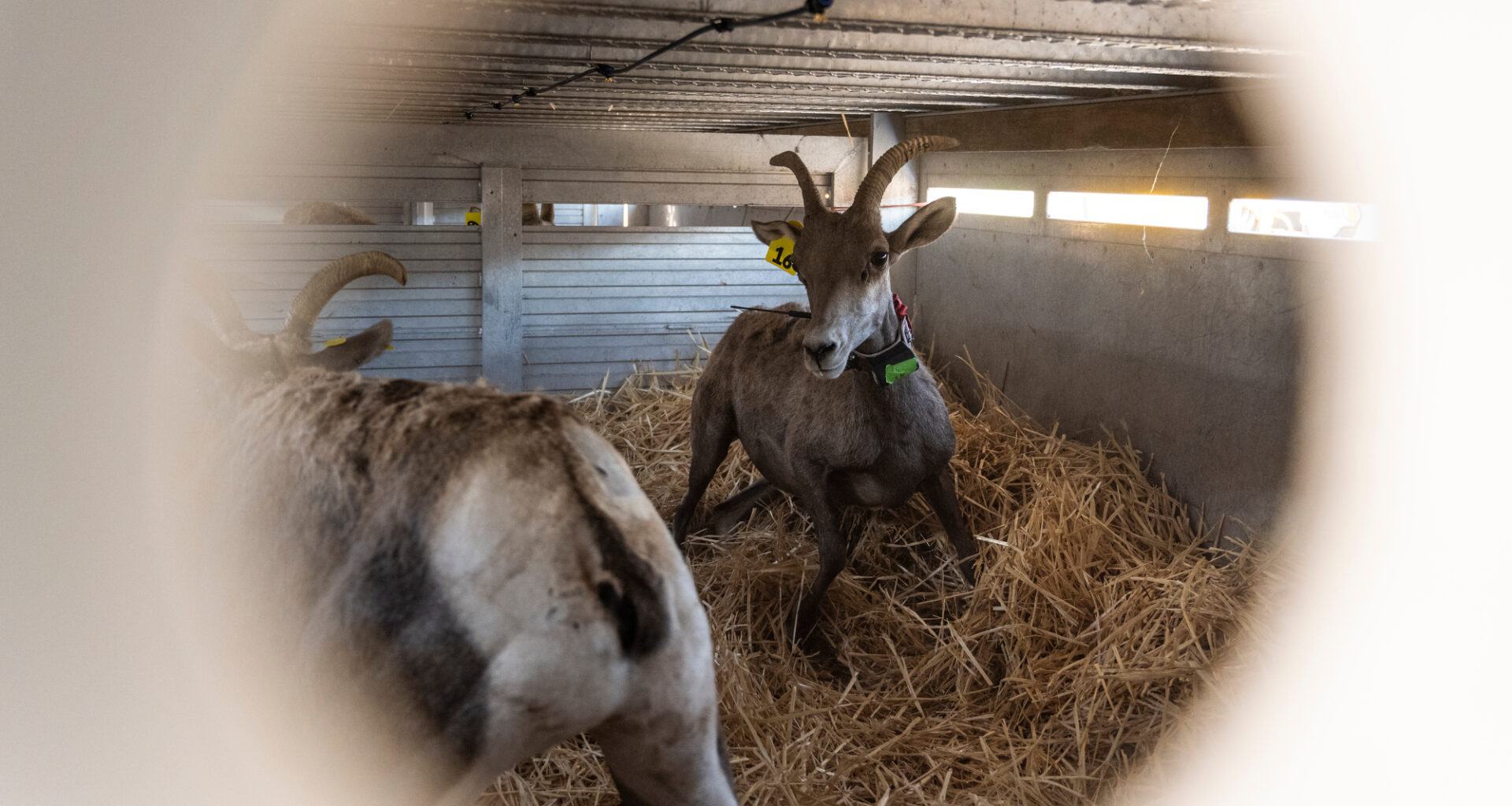Fifty miles northeast of Las Vegas, helicopter blades cut through hot summer air, the sound echoing among sandstone cliffs in Valley of Fire State Park. Beneath a helicopter, sedated, blindfolded and secured in specialized transport bag, two desert bighorn sheep hang from a cable.
This is all part of a desert bighorn sheep capture and translocation project June 10 organized by the Nevada Department of Wildlife and Utah Division of Wildlife Resources. By capturing and relocating 139 sheep, they hope to reduce overexploitation of water and forage resources in the Muddy Mountains and leave the majority of the sheep population to remain comfortably.
The process of capturing, processing, documenting and translocating the sheep is highly organized, involving partnerships with more than 12 organizations across multiple states.
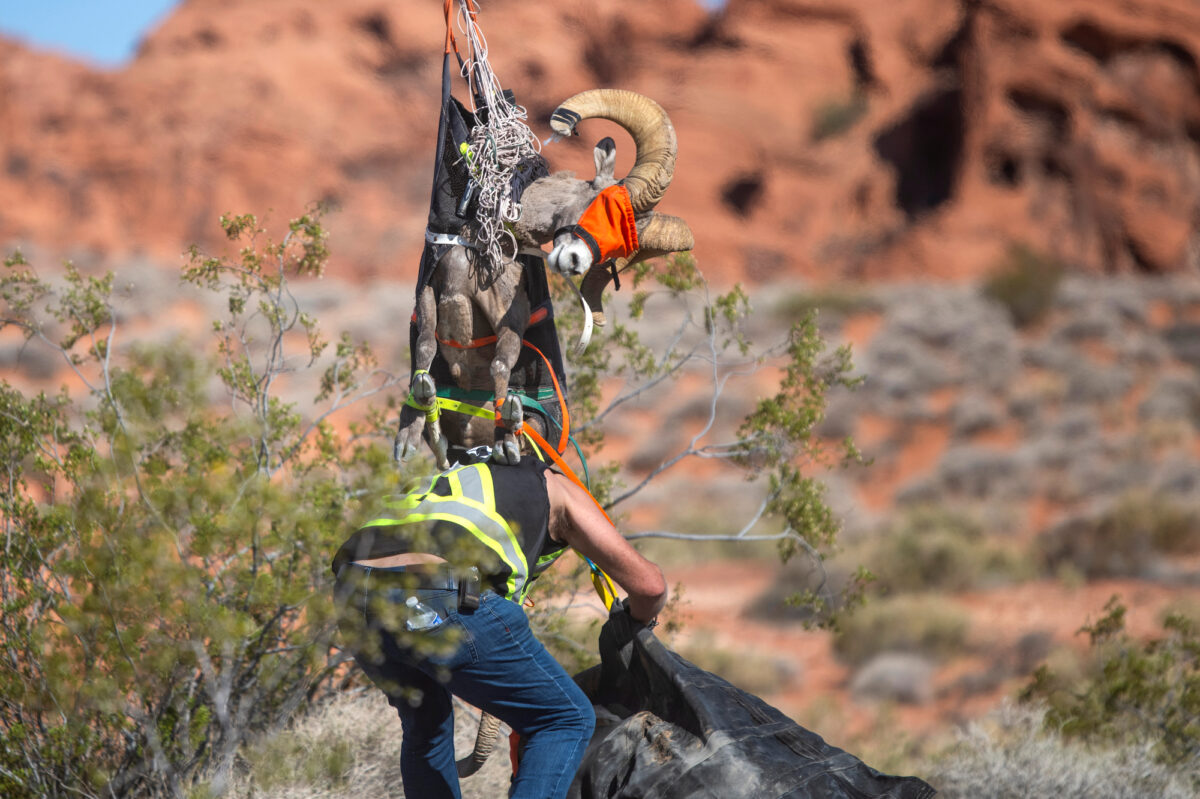 Two desert bighorn sheep are ferried by helicopter to base camp for processing during a capture and translocation operation run by the Nevada Department of Wildlife in Valley of Fire State Park on June 10, 2025. (Daniel Clark/The Nevada Independent)
Two desert bighorn sheep are ferried by helicopter to base camp for processing during a capture and translocation operation run by the Nevada Department of Wildlife in Valley of Fire State Park on June 10, 2025. (Daniel Clark/The Nevada Independent)
Desert bighorn sheep are captured via a net-gun, given a sedative, blindfolded, secured in a sling bag, and then transported via helicopter to a base camp. Once the sheep arrive, they are lowered safely onto the drop zone, and the cable is detached.
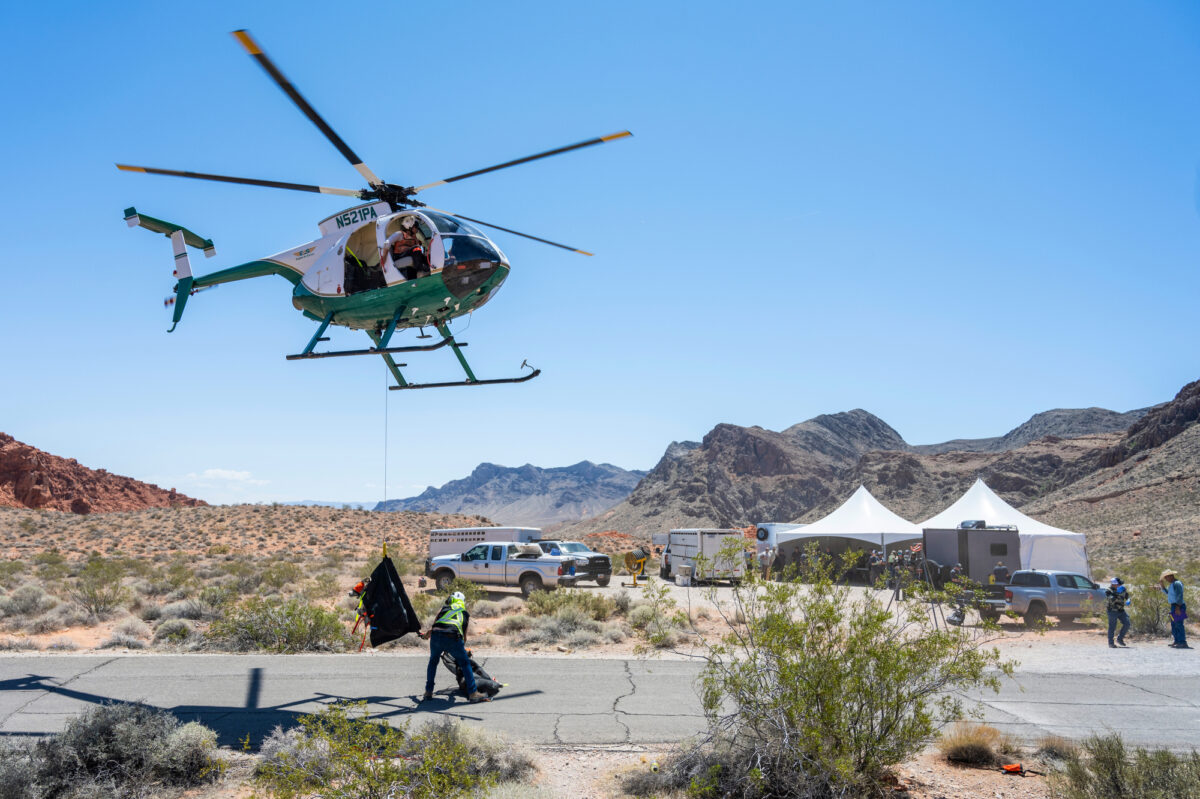 Two desert bighorn sheep are ferried by helicopter to base camp for processing during a capture and translocation operation run by the Nevada Department of Wildlife in Valley of Fire State Park on June 10, 2025. (Daniel Clark/The Nevada Independent)
Two desert bighorn sheep are ferried by helicopter to base camp for processing during a capture and translocation operation run by the Nevada Department of Wildlife in Valley of Fire State Park on June 10, 2025. (Daniel Clark/The Nevada Independent)
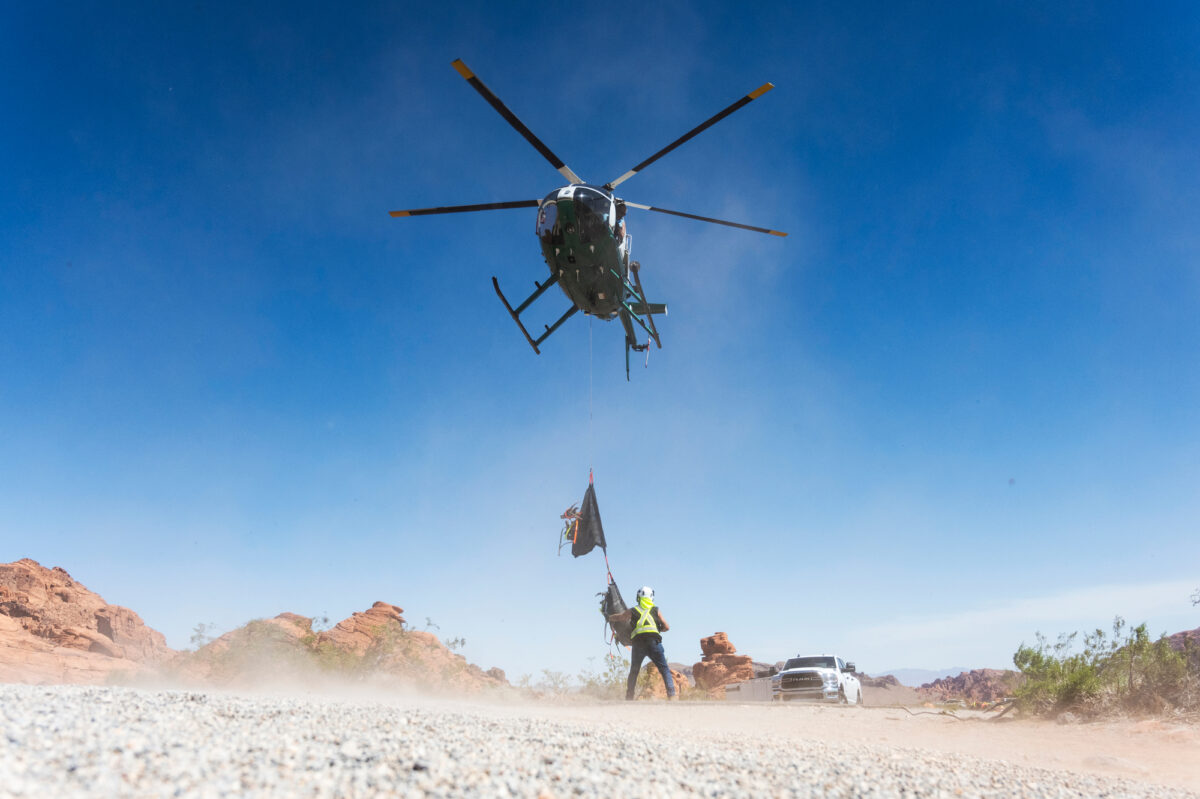 Two desert bighorn sheep are ferried by helicopter to base camp for processing during a capture and translocation operation run by the Nevada Department of Wildlife in Valley of Fire State Park on June 10, 2025. (Daniel Clark/The Nevada Independent)
Two desert bighorn sheep are ferried by helicopter to base camp for processing during a capture and translocation operation run by the Nevada Department of Wildlife in Valley of Fire State Park on June 10, 2025. (Daniel Clark/The Nevada Independent)
After the helicopter moves off, a handling team retrieves the sheep and carries them to a scale to be weighed. Afterward, the animals are carried to the processing tent and removed from their sling bags.
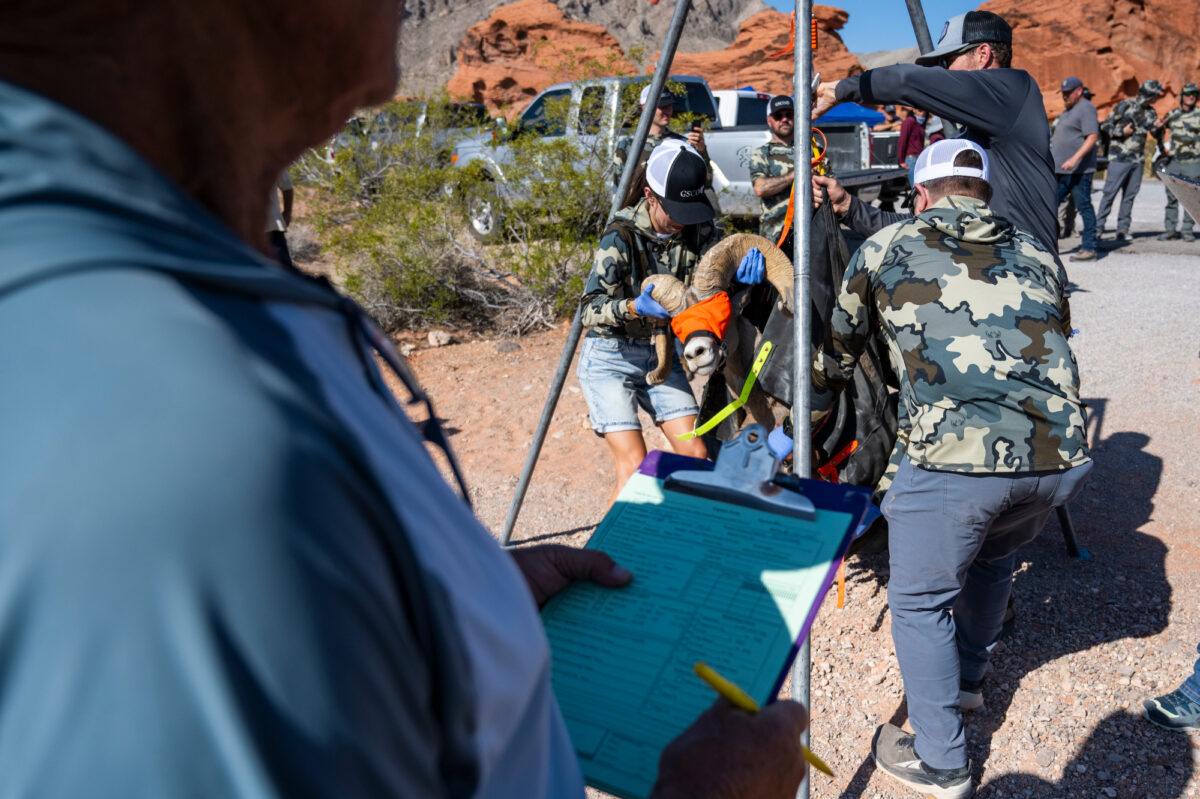 A desert bighorn sheep is weighed before being processed during a capture and translocation operation run by the Nevada Department of Wildlife in Valley of Fire State Park on June 10, 2025. (Daniel Clark/The Nevada Independent)
A desert bighorn sheep is weighed before being processed during a capture and translocation operation run by the Nevada Department of Wildlife in Valley of Fire State Park on June 10, 2025. (Daniel Clark/The Nevada Independent)
 A desert bighorn sheep is carried to the processing tent during a capture and translocation operation run by the Nevada Department of Wildlife in Valley of Fire State Park on June 10, 2025. (Daniel Clark/The Nevada Independent)
A desert bighorn sheep is carried to the processing tent during a capture and translocation operation run by the Nevada Department of Wildlife in Valley of Fire State Park on June 10, 2025. (Daniel Clark/The Nevada Independent)
The initial focus of the processing team is animal safety. With temperatures over 100 degrees Fahrenheit, the first task is to cool the animals down. The team takes each animal’s temperature, inserts an oxygen hose into its nostril, and applies ice water-soaked towels strategically.
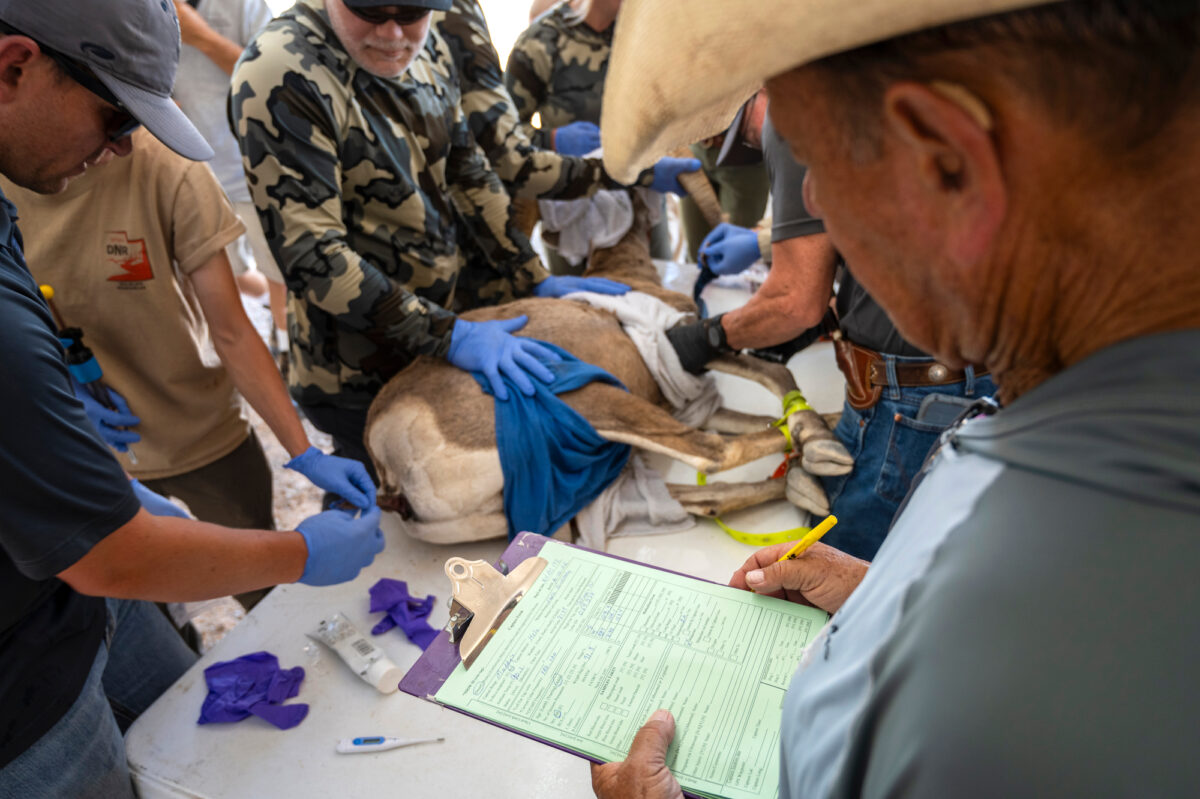 A desert bighorn sheep is processed during a capture and translocation operation run by the Nevada Department of Wildlife in Valley of Fire State Park on June 10, 2025. (Daniel Clark/The Nevada Independent)
A desert bighorn sheep is processed during a capture and translocation operation run by the Nevada Department of Wildlife in Valley of Fire State Park on June 10, 2025. (Daniel Clark/The Nevada Independent)
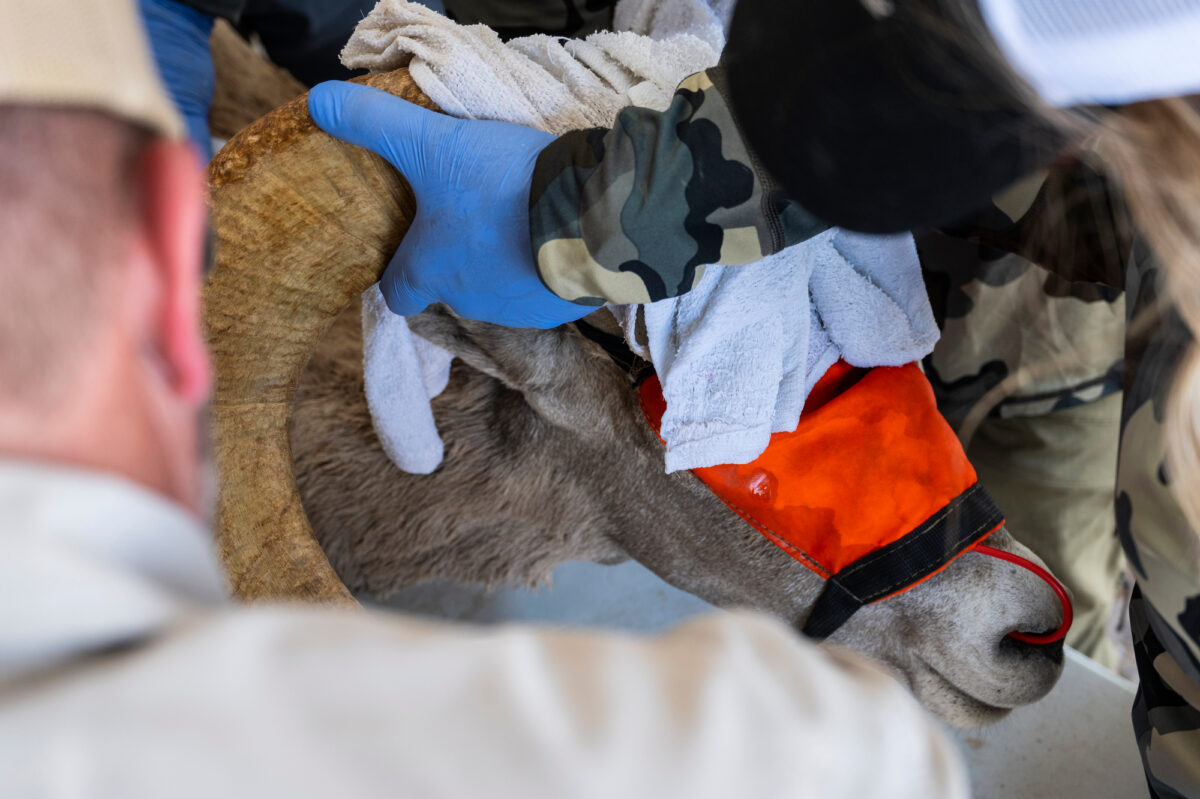 A desert bighorn sheep is processed during a capture and translocation operation run by the Nevada Department of Wildlife in Valley of Fire State Park on June 10, 2025. (Daniel Clark/The Nevada Independent)
A desert bighorn sheep is processed during a capture and translocation operation run by the Nevada Department of Wildlife in Valley of Fire State Park on June 10, 2025. (Daniel Clark/The Nevada Independent)
The team then conducts a thorough physical exam including, age, sex, heart rate and a series of other physical observations. Additionally, samples of blood and feces are taken, as well as an oropharyngeal swab inside the animal’s throat.
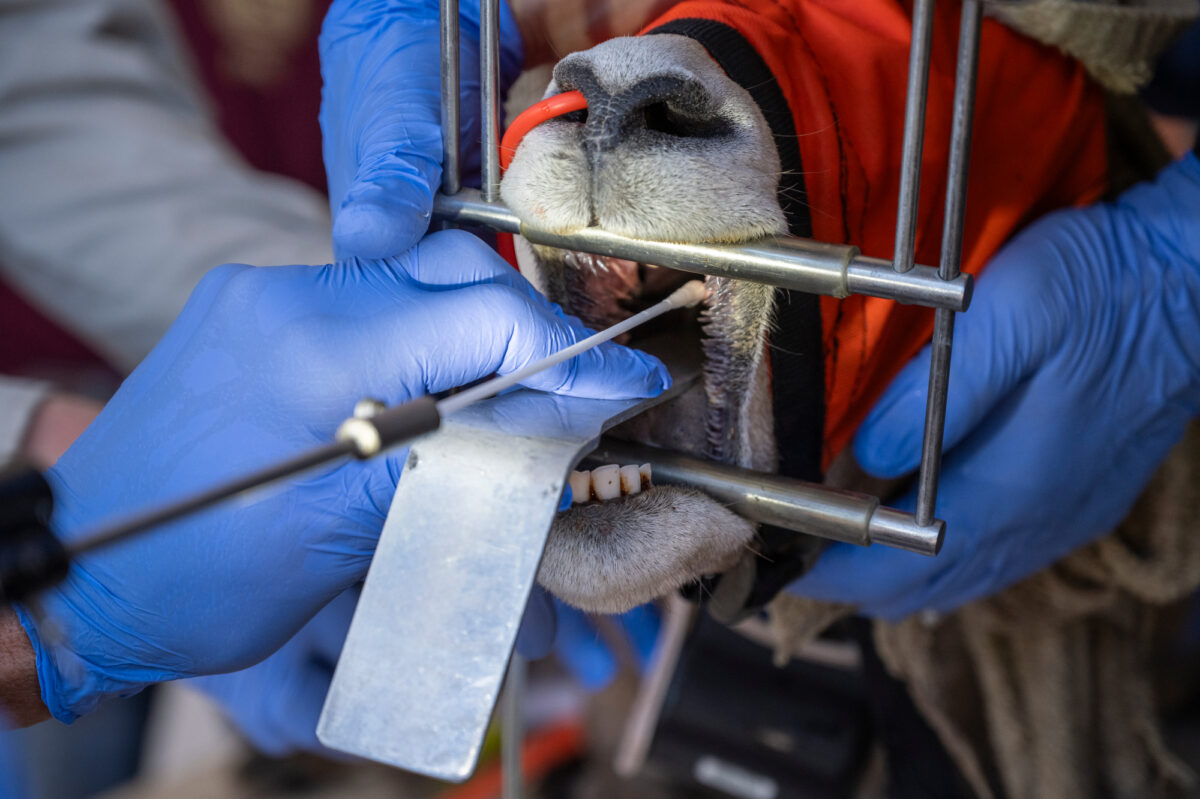 A desert bighorn sheep has its throat swabbed during a capture and translocation operation run by the Nevada Department of Wildlife in Valley of Fire State Park on June 10, 2025. (Daniel Clark/The Nevada Independent)
A desert bighorn sheep has its throat swabbed during a capture and translocation operation run by the Nevada Department of Wildlife in Valley of Fire State Park on June 10, 2025. (Daniel Clark/The Nevada Independent)
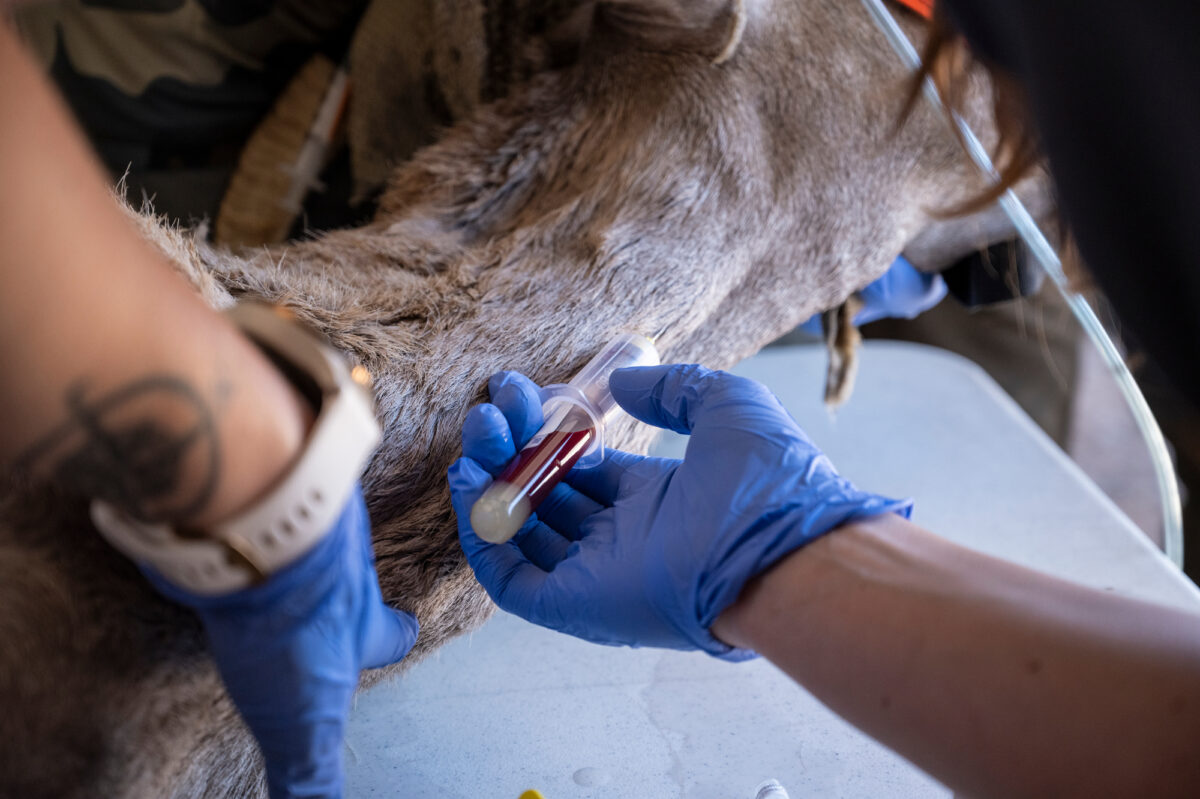 A desert bighorn sheep has blood samples drawn during a capture and translocation operation run by the Nevada Department of Wildlife in Valley of Fire State Park on June 10, 2025. (Daniel Clark/The Nevada Independent)
A desert bighorn sheep has blood samples drawn during a capture and translocation operation run by the Nevada Department of Wildlife in Valley of Fire State Park on June 10, 2025. (Daniel Clark/The Nevada Independent)
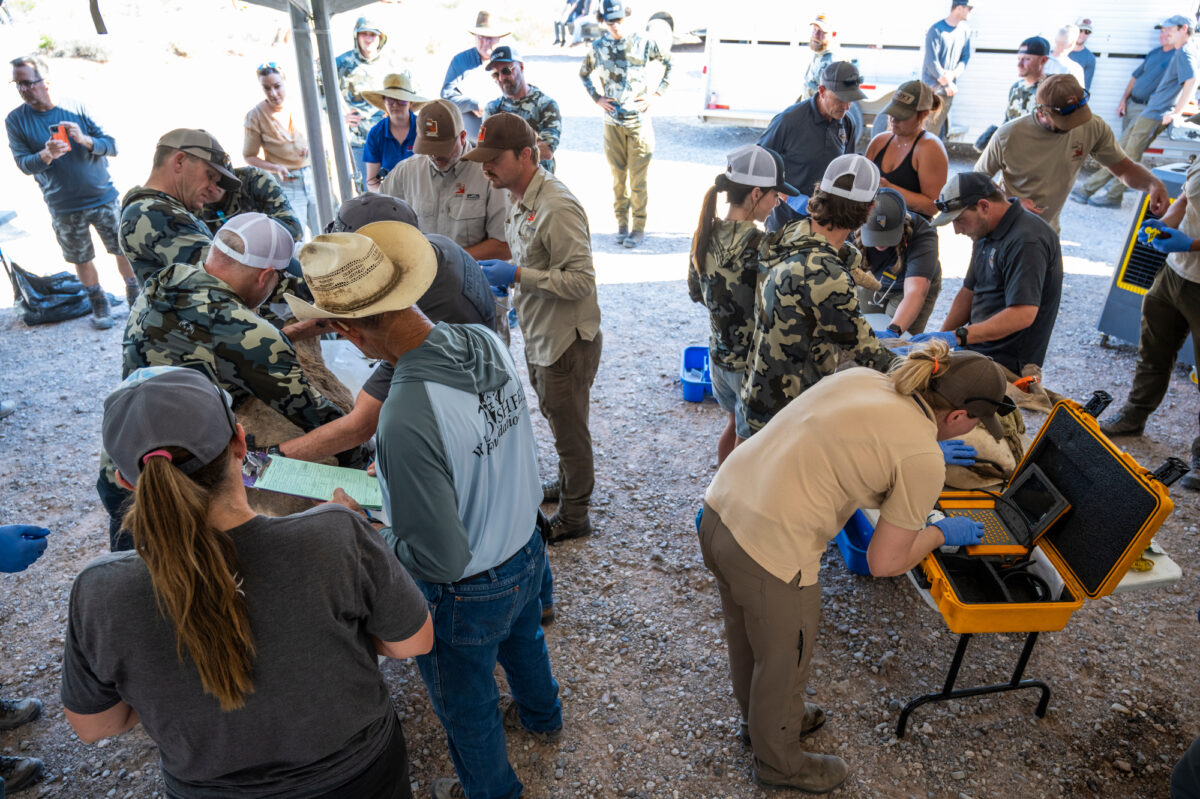 Two desert bighorn sheep are processed during a capture and translocation operation run by the Nevada Department of Wildlife in Valley of Fire State Park on June 10, 2025. (Daniel Clark/The Nevada Independent)
Two desert bighorn sheep are processed during a capture and translocation operation run by the Nevada Department of Wildlife in Valley of Fire State Park on June 10, 2025. (Daniel Clark/The Nevada Independent)
Next, the animal is fitted with a radio collar and an ear tag to ensure that it is properly tracked.
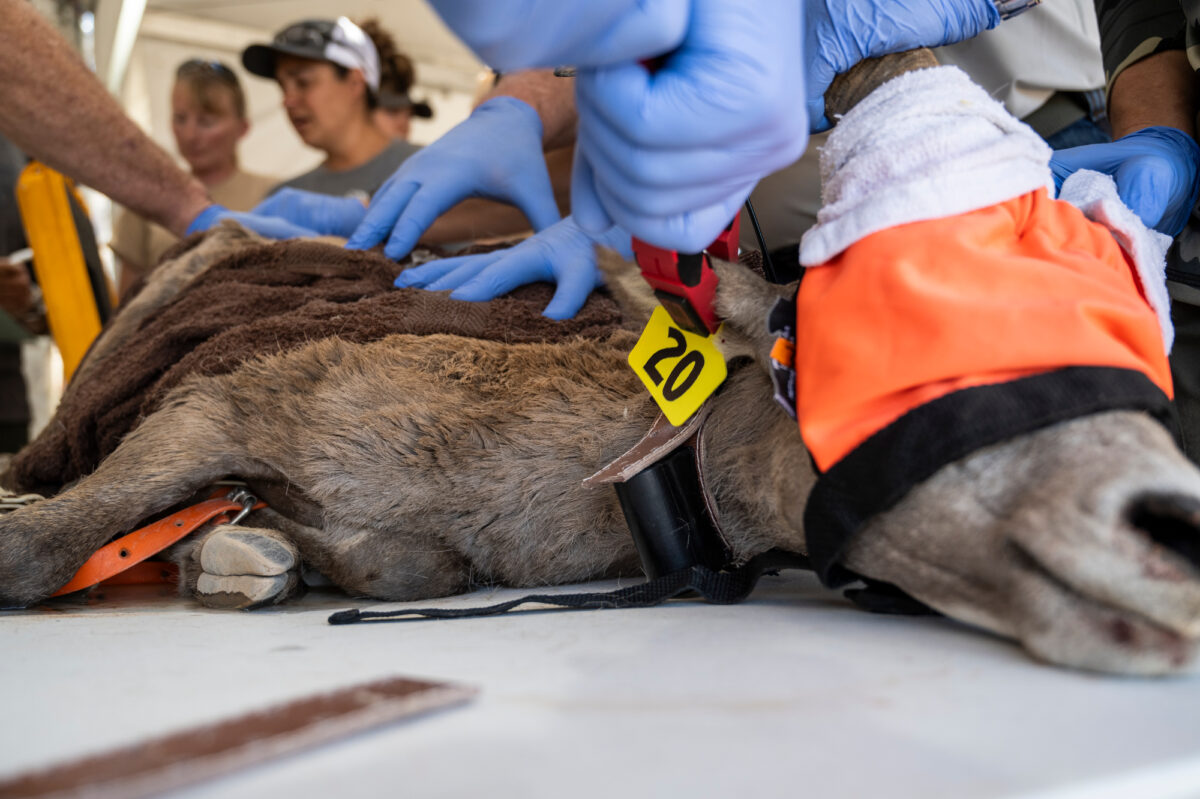 A desert bighorn sheep is tagged during a capture and translocation operation run by the Nevada Department of Wildlife in Valley of Fire State Park on June 10, 2025. (Daniel Clark/The Nevada Independent)
A desert bighorn sheep is tagged during a capture and translocation operation run by the Nevada Department of Wildlife in Valley of Fire State Park on June 10, 2025. (Daniel Clark/The Nevada Independent)
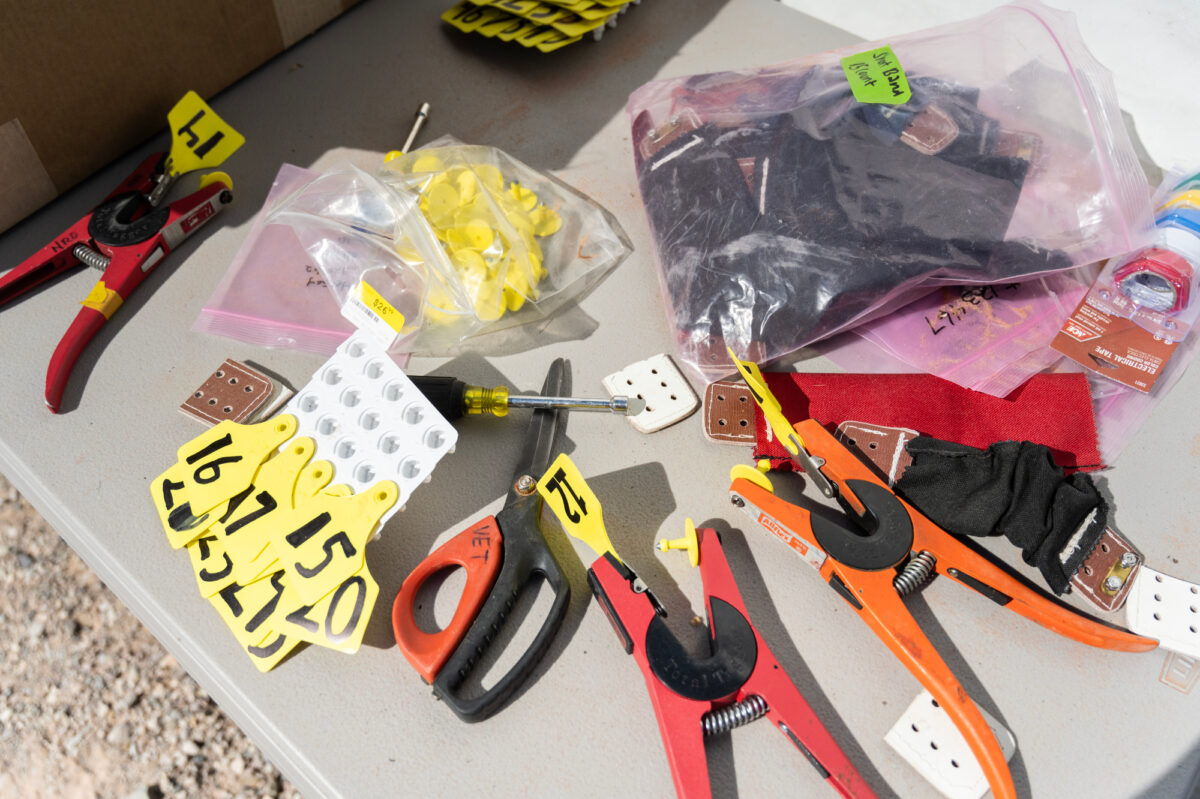 Tools for tagging animals as seen during a desert bighorn sheep capture and translocation operation run by the Nevada Department of Wildlife in Valley of Fire State Park on June 10, 2025. (Daniel Clark/The Nevada Independent)
Tools for tagging animals as seen during a desert bighorn sheep capture and translocation operation run by the Nevada Department of Wildlife in Valley of Fire State Park on June 10, 2025. (Daniel Clark/The Nevada Independent)
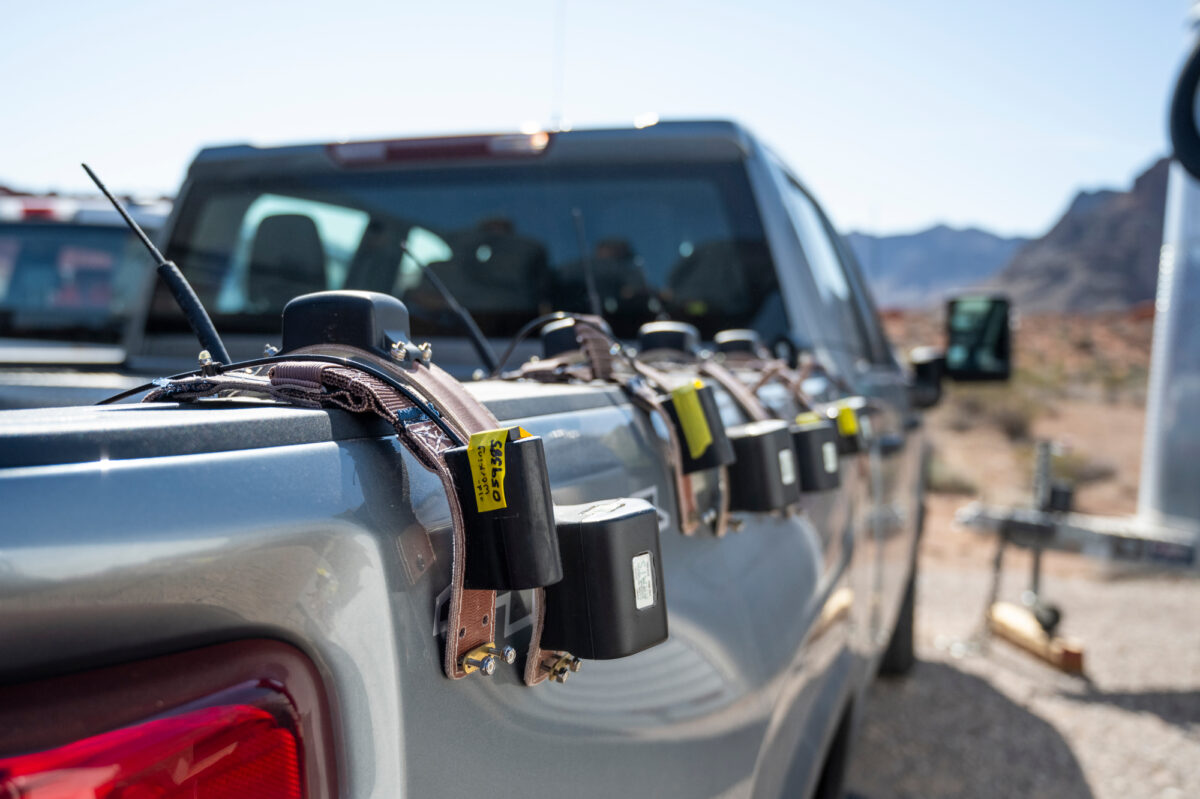 Tracking collars await captured desert bighorn sheep during a capture and translocation operation run by the Nevada Department of Wildlife in Valley of Fire State Park on June 10, 2025. (Daniel Clark/The Nevada Independent)
Tracking collars await captured desert bighorn sheep during a capture and translocation operation run by the Nevada Department of Wildlife in Valley of Fire State Park on June 10, 2025. (Daniel Clark/The Nevada Independent)
Once the entire processing routine is complete, and the data sheet is fully filled out, a team carries the sheep to a trailer and loads it inside. Males, females, and young sheep are kept separately for the safety of the animals. Occasionally, a misting system inside the trailer will be turned on to make sure that the animals inside are kept cool.
 A desert bighorn sheep is loaded into to a trailer during a capture and translocation operation run by the Nevada Department of Wildlife in Valley of Fire State Park on June 10, 2025. (Daniel Clark/The Nevada Independent)
A desert bighorn sheep is loaded into to a trailer during a capture and translocation operation run by the Nevada Department of Wildlife in Valley of Fire State Park on June 10, 2025. (Daniel Clark/The Nevada Independent)
 A desert bighorn sheep is carried to a trailer during a capture and translocation operation run by the Nevada Department of Wildlife in Valley of Fire State Park on June 10, 2025. (Daniel Clark/The Nevada Independent)
A desert bighorn sheep is carried to a trailer during a capture and translocation operation run by the Nevada Department of Wildlife in Valley of Fire State Park on June 10, 2025. (Daniel Clark/The Nevada Independent)
 A desert bighorn sheep rests in a trailer after being processed during a capture and translocation operation run by the Nevada Department of Wildlife in Valley of Fire State Park on June 10, 2025. (Daniel Clark/The Nevada Independent)
A desert bighorn sheep rests in a trailer after being processed during a capture and translocation operation run by the Nevada Department of Wildlife in Valley of Fire State Park on June 10, 2025. (Daniel Clark/The Nevada Independent)
 A desert bighorn sheep is loaded into to a trailer during a capture and translocation operation run by the Nevada Department of Wildlife in Valley of Fire State Park on June 10, 2025. (Daniel Clark/The Nevada Independent)
A desert bighorn sheep is loaded into to a trailer during a capture and translocation operation run by the Nevada Department of Wildlife in Valley of Fire State Park on June 10, 2025. (Daniel Clark/The Nevada Independent)
This capture and translocation procedure is performed for as many sheep as can be safely processed that day. Many of the sheep captured in this project will be joining a nursery herd in Utah, with others going to the Tobin and Cortez ranges in Nevada.
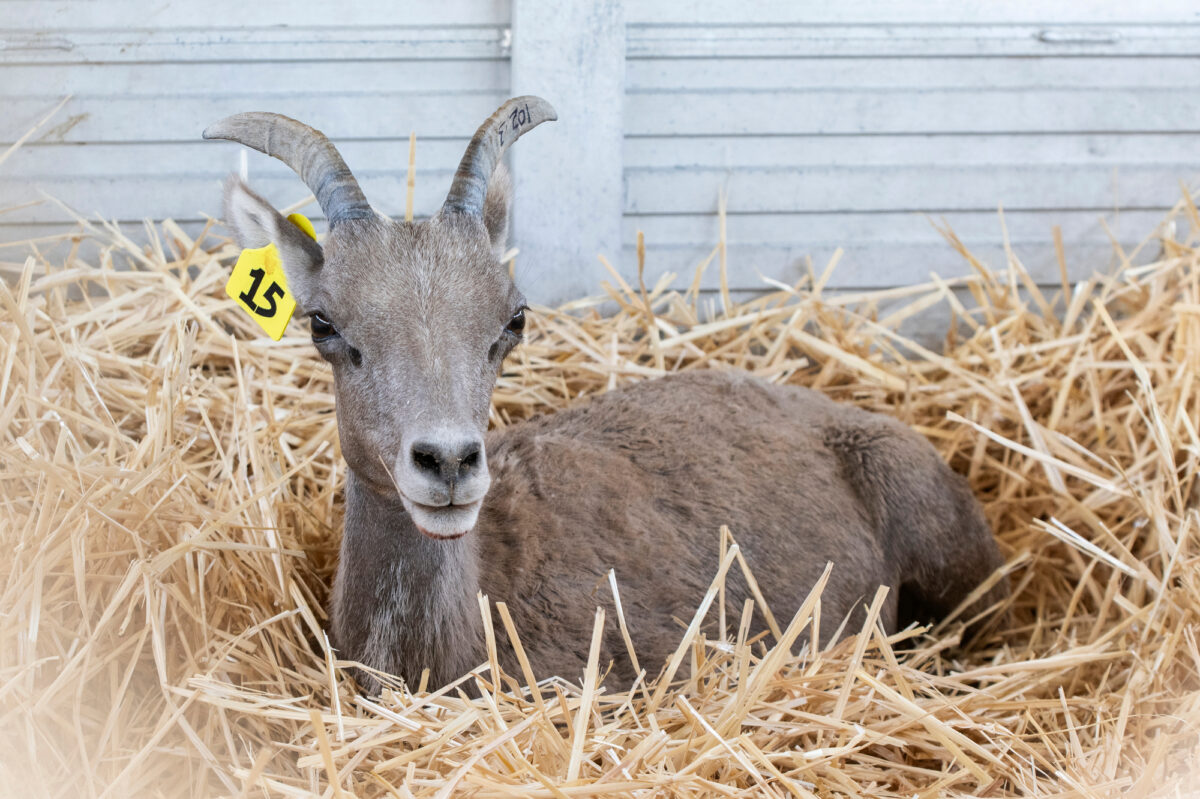 A desert bighorn sheep rests in a trailer after being processed during a capture and translocation operation run by the Nevada Department of Wildlife in Valley of Fire State Park on June 10, 2025. (Daniel Clark/The Nevada Independent)
A desert bighorn sheep rests in a trailer after being processed during a capture and translocation operation run by the Nevada Department of Wildlife in Valley of Fire State Park on June 10, 2025. (Daniel Clark/The Nevada Independent)
